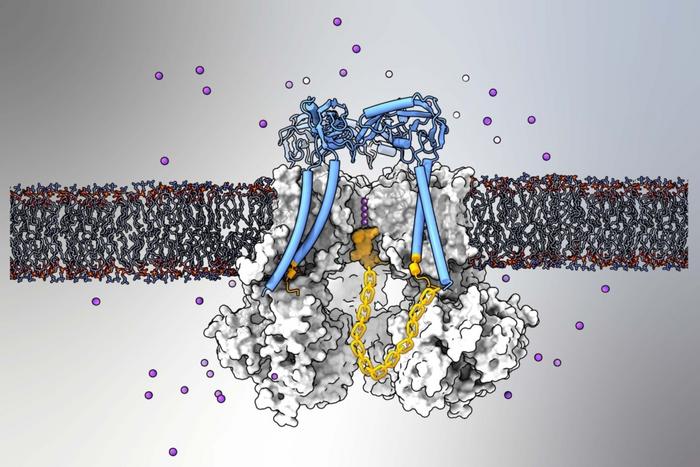
A transformative study conducted by researchers at Weill Cornell Medicine has provided unprecedented insights into the BK (big potassium) ion channel, a critical protein structure that facilitates potassium ion flow in mammalian cells. The recent publication in Nature Communications unveils how this ion channel employs a sophisticated “ball-and-chain” mechanism to regulate its activity. This discovery not only enhances our understanding of the biological roles played by ion channels but also carries the potential for developing therapeutic interventions for a range of disorders, including epilepsy and hypertension.
Ion channels, which are essential for numerous physiological processes, are embedded in cell membranes, allowing charged ions to traverse in and out of cells. These channels are indispensable for effective communication between nerve cells, controlling excitability in both neuronal and muscular systems. The BK channel, specifically, is vital for the regulation of cellular excitability and the maintenance of electrical signaling in a variety of tissues. Its operation hinges on the flow of potassium ions, where any malfunction can lead to severe pathological conditions.
The research refers to the long-suspected “ball-and-chain” mechanism that facilitates the BK channel’s ability to stop ion flow. This study marks a significant benchmark as it provides direct imaging confirmation of the ball-like structure that acts as a plug for the channel. The ability to visualize this structure was made possible through advanced techniques such as cryo-electron microscopy (cryo-EM), demonstrating the dynamic nature of the BK channel’s regulation in a biologically relevant context.
Historically, the ball-and-chain concept had been theorized but remained elusive due to the intricacies involved in capturing the structural dynamics of such proteins. Previous efforts featured in 2020 led by Dr. Crina Nimigean successfully visualized a similar mechanism in a simpler potassium channel, yet the current investigation represents a key breakthrough by elucidating the structure within the more complex mammalian BK channel. Dr. Nimigean’s team employed cutting-edge structural imaging techniques to stabilize and examine the inherently flexible BK channel, ultimately revealing how the calcium-activated gating mechanism operates to halt ion flow.
Integral to this research was the collaboration with computational biophysicists who aided in modeling the dynamic conformations of the protein plug and its interaction with the channel. The findings revealed critical insights into the role of the first few amino acids in the plug, which are essential for establishing a connection to the channel pore. The remaining amino acids apparently contribute to the flexibility needed for effective gating, allowing the channel to reactively engage or disengage from its exposed state.
As a pivotal player in physiological regulation, the BK channel’s influence stretches across a variety of functions, including blood flow modulation, auditory signal processing, and even the stabilization of neuromuscular junctions. Genetic alterations or dysfunctions in these pathways have been associated with diverse neurological and cardiovascular disorders, cementing the need for further exploration of ion channel regulation mechanisms.
The study has opened new avenues for therapeutic exploration, focusing on how engineered drugs might selectively target BK channel activity. By capitalizing on the newly defined ball-and-chain mechanism, there could be promising implications for designing treatments that restore or modify ion flow in pathological states, including chronic conditions like epilepsy accompanied by abnormal neuronal excitability.
Current research by Dr. Nimigean’s group also aims to investigate the impact of membrane-associated lipid molecules on BK channel activity. Understanding how these lipids affect channel function could reveal additional layers of regulation and pave the way for innovative strategies to modulate BK channel behavior in health and disease.
The advances gained through this inquiry not only unravel a fundamental biological conundrum but also engender a greater appreciation for the complexity of ion channel specialization. The dynamic regulation of BK channels may represent a microcosmic reflection of broader principles of cellular communication and adaptation, where small molecular interactions dictate larger physiological outcomes.
In synthesizing these findings with potential clinical applications, the discourse surrounding ion channels and their therapeutic modulation now stands at a crossroads. The detailed molecular understanding garnered through this research is poised to inform future investigations, ultimately culminating in therapeutic strategies tailored to deftly intervene in ion channel-mediated conditions and enhance quality of life for patients afflicted by these disorders.
The implications of these revelations extend beyond the immediate context of the BK channel, serving as a cornerstone for future research trajectories in the field of neurobiology and cardiac health. The intersection of biophysics, molecular modeling, and biomedical application epitomizes a forward-thinking approach to tackling diseases at the molecular level. The strength of the research lies in its interdisciplinary nature, inviting collaboration across realms to harness scientific inquiry for tangible health interventions.
Ultimately, this extensive study exemplifies the convergence of basic research and clinical applications, showcasing how insights into the microscopic world of ion channels can ripple out to affect real-world health outcomes. This paradigm of understanding emphasizes the critical role of ongoing research in elucidating the nuances of cellular mechanisms, providing hope for the development of much-needed therapeutics for debilitating syndromes affecting millions.
Subject of Research: BK ion channel and its regulation via ball-and-chain mechanism
Article Title: Study Establishes “Ball and Chain” Mechanism Inactivates Key Mammalian Ion Channel
News Publication Date: 19-Feb-2025
Web References: https://www.nature.com/articles/s41467-025-56844-4
References: https://news.weill.cornell.edu/news/2020/03/ball-and-chain-inactivation-of-ion-channels-visualized-by-cryo-electron-microscopy
Image Credits: Elizabeth Kim
Keywords: Ion channels, BK channel, ball-and-chain mechanism, potassium ions, cell membrane, cryo-electron microscopy, neurobiology, therapeutics, epilepsy, hypertension.
Tags: ball-and-chain mechanism in ion channelsBK ion channel mechanismcellular excitability and ion channelselectrical signaling in tissueshypertension and ion channelsion channel structure and functionmammalian ion channels and diseasesNature Communications publication on ion channelsneuronal communication and ion channelspotassium ion flow regulationtherapeutic interventions for epilepsyWeill Cornell Medicine research





